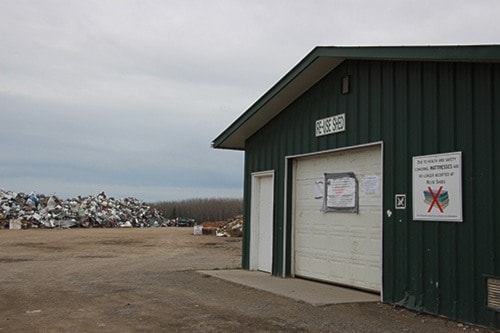Over 60 community members, some more vocal than others, attended a public meeting on Vanderhoof’s now-closed re-use shed at the Nechako Senior Citizens Friendship Centre on Oct. 14 evening.
One of the six meetings hosted by the Regional District of Bulkley-Nechako (RDBN) in communities including Fraser Lake and Fort St. James, the event was intended for attendees to gather in small groups and make written suggestions to address re-used shed concerns as outlined by the regional district — while a RDBN representative mingled among the residents for individual chats, said RDBN’s Director of Environmental Services Janine Dougall.
However, the meeting became a group discussion as some individuals moved tables into a circle, and others leaving midway as the exchange of comments became more heated.
Some attendees lauded the re-use shed’s function as a 24-hour centre facilitating an exchange of re-usable household items that would have otherwise added to the landfill, while others raised doubts against the RDBN’s public safety and liability concerns from the lack of re-use shed supervision.
At the meeting, the Nechako Waste Reduction Initiative (NWRI), a member group of the Nechako Healthy Community Alliance, proposed to have an larger re-use shed space authorized by the regional district, as well as possibly providing a part-time employee from the Initiative that would be compensated by nominal resales of the dropped off items, said NWRI’s Zoe Dhillon.
“Based on what Janine said, we’re not going forward with what we have,” said Dhillon. “So what is the best scenario to make that change.”
Before that, NWRI is suggesting a trial period of six weeks to survey the re-use shed’s activities and usage, said Karen Scheffers from the alliance.
“Just to see what we’re dealing with,” Scheffers said. “We’ve never monitored what we actually do up there.”
She added,”It has been a valuable resource and I see more value in it for people who want to start building and creating things with those resources that are up there; they are free.”
For Trudy Northrup, who has moved from New Brunswick to Vanderhoof in 2013, the re-use shed had provided her family with a variety of household items including a wash machine, kitchen supplies, as well as lamps.
“When we came out, my husband and I just had our clothes,” Northrup said. “We didn’t have any personal belongings, furniture or anything.”
For Mayor Gerry Thiessen, the concern lies in the cost implication of hiring staff for the re-use shed.
“The biggest thing I’m afraid of, for my community, is that the only solution we have is raise more taxes, and hire someone there to police it,” Thiessen said. “If they’re not volunteers, by the time you pay all the wages and benefits, and to cover the hours that some of the people are asking…that could be a huge cost to the community of Vanderhoof.”
Jerry Petersen, RDBN’s director of rural Vanderhoof, said the public has to be aware that it’s going to cost, for the re-use sheds to resume running.
“We try to run a safe environment,” Petersen said. “Not long after the transfer station was open, it progressively got worse over the years, as more people use it and see what’s there.”
He added, “It becomes a fight between somebody that really wants to get something for themselves, or somebody to make a business of it.”
Results from the public meetings on re-use sheds will be compiled in a report to be released in the following weeks, said Dougall.
Re-use sheds in six communities of the regional district are closed “until or unless a safe solution is found…due to safety concerns and legal liability to the taxpayers of the Regional District of Bulkley-Nechako,” according to a motion passed by the RDBN’s board on Aug. 20.
